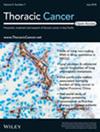Causal relationships between immune cell phenotypes and lung adenocarcinoma: A bidirectional two‐sample Mendelian randomization study
IF 2.3
3区 医学
Q3 ONCOLOGY
引用次数: 0
Abstract
BackgroundLung adenocarcinoma (LUAD) is the most common type of lung cancer and closely associated with the immune system. Emerging evidence suggests that blood immune cell phenotypes in patients with LUAD may undergo alterations. Nevertheless, the limited amount of relevant research makes it difficult to understand the causal links between LUAD and changes in the immune cells. This study aimed to reveal the potential causal relationships between 731 immune cell phenotypes and LUAD.MethodsA bidirectional two‐sample Mendelian randomization (MR) analysis was used to clarify causal relationships. Four types of immune phenotypes, absolute cell counts, relative cell counts, median fluorescence intensities (MFIs) of surface antigens, and morphological parameters, were investigated in this study. Heterogeneity tests, horizontal pleiotropy tests, and leave‐one‐out analyses were performed to validate the reliability of our study.ResultsA total of 26 immune cell characteristics were identified as contributing to the occurrence of LUAD. Memory B cells, IgD免疫细胞表型与肺腺癌之间的因果关系:双向双样本孟德尔随机研究
背景肺腺癌(LUAD)是最常见的肺癌类型,与免疫系统密切相关。新的证据表明,肺腺癌患者的血液免疫细胞表型可能会发生改变。然而,由于相关研究数量有限,很难了解 LUAD 与免疫细胞变化之间的因果关系。本研究旨在揭示 731 种免疫细胞表型与 LUAD 之间的潜在因果关系。本研究调查了四种类型的免疫表型,即绝对细胞数、相对细胞数、表面抗原的中位荧光强度(MFIs)和形态参数。为了验证我们研究的可靠性,我们进行了异质性检验、水平多向性检验和漏出分析。记忆B细胞、IgD-CD38br细胞、CD4+调节性T细胞(Tregs)和浆细胞状树突状细胞(DCs)可能在LUAD的发病中发挥作用。通过反向 MR,我们的研究发现,LUAD 的存在还诱导了 16 种免疫细胞性状表达水平的变化,这些性状涉及特异性表面标志物和各种类型的免疫细胞,其中一些与抗原递呈和免疫激活过程有关。
本文章由计算机程序翻译,如有差异,请以英文原文为准。
求助全文
约1分钟内获得全文
求助全文
来源期刊

Thoracic Cancer
ONCOLOGY-RESPIRATORY SYSTEM
CiteScore
5.20
自引率
3.40%
发文量
439
审稿时长
2 months
期刊介绍:
Thoracic Cancer aims to facilitate international collaboration and exchange of comprehensive and cutting-edge information on basic, translational, and applied clinical research in lung cancer, esophageal cancer, mediastinal cancer, breast cancer and other thoracic malignancies. Prevention, treatment and research relevant to Asia-Pacific is a focus area, but submissions from all regions are welcomed. The editors encourage contributions relevant to prevention, general thoracic surgery, medical oncology, radiology, radiation medicine, pathology, basic cancer research, as well as epidemiological and translational studies in thoracic cancer. Thoracic Cancer is the official publication of the Chinese Society of Lung Cancer, International Chinese Society of Thoracic Surgery and is endorsed by the Korean Association for the Study of Lung Cancer and the Hong Kong Cancer Therapy Society.
The Journal publishes a range of article types including: Editorials, Invited Reviews, Mini Reviews, Original Articles, Clinical Guidelines, Technological Notes, Imaging in thoracic cancer, Meeting Reports, Case Reports, Letters to the Editor, Commentaries, and Brief Reports.
 求助内容:
求助内容: 应助结果提醒方式:
应助结果提醒方式:


